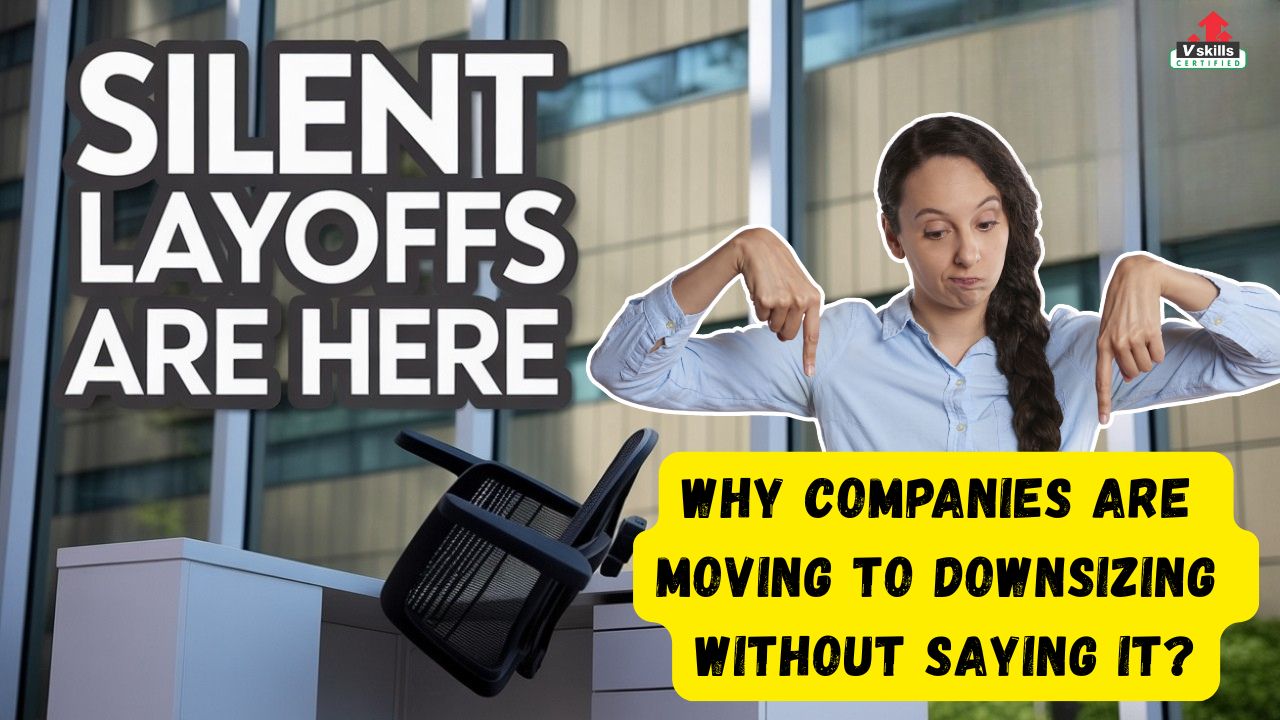You’re still employed on paper, but your responsibilities are fading, meetings are fewer, and your inbox is oddly quiet. Welcome to the age of the silent layoff. In a post-pandemic corporate world, layoffs are not always announced with pink slips and HR meetings. Instead, a subtle but growing layoff trend is taking over, where employees are quietly pushed out without being formally let go. As economic uncertainty looms and companies try to protect their reputation, this invisible form of downsizing is reshaping the modern workplace. Understanding these layoff trends is key to protecting your career before it’s too late.
Silent layoffs, also known as quiet firing, refer to the indirect and often non-transparent ways organizations push employees out without formally terminating their employment. Instead of issuing a formal layoff notice, companies create an environment where the employee feels unwelcome, undervalued, or stagnant — essentially nudging them to resign on their own.
How Silent Layoffs Differ from Official Layoffs or Job Cuts
| Aspect | Silent layoffs/ Quiet firing | Official layoffs/ Job cuts |
| Transparency | Implicit, covert, and rarely acknowledged by the company | Explicit and announced formally |
| Communication | Lack of clear communication regarding job status | Formal notifications and HR involvement |
| Employee exit | Employee quits voluntarily, often due to pressure | Employee is formally let go |
| Legal and financial obligations | Often avoids severance, unemployment claims | Usually involves severance packages and legal compliance |
| Public image | Maintains the company’s image by not laying off people | Public and internal acknowledgement of job reduction |
Signs of Silent Layoffs
Not all layoffs come with big announcements or pink slips. Sometimes, they happen quietly—through reduced hours, vanished responsibilities, or constant restructuring. These are called silent layoffs, and they can catch employees off guard. While nothing may be said out loud, the signs are often right in front of you—if you know what to look for. In this video, we’ll break down the subtle red flags that could mean your company is quietly trimming the workforce.
1. Being Excluded from Meetings or Decision-Making
You are no longer invited to key meetings or strategy sessions. Once you were an active participant and your opinion held great weight, but now your input is ignored or overlooked in decisions that affect your role.
2. Tasks and responsibilities are removed
Your projects, on which you have invested a great deal of time and energy, are suddenly reassigned to someone else without any valid explanation. Your role in the company becomes increasingly vague. There is no job satisfaction as the work you are passionate about and really make a difference is not being assigned to you.
3. Lack of Performance Feedback or Growth Opportunities
If there is any work assigned to you that is not significantly used in further creative processes. Hence, you don’t get any constructive criticism or feedback about the changes that can take place in your work. No reviews mean your output is not highlighted enough or used, which makes its existence unnecessary.
4. No Promotions or Raises Despite Tenure
Despite hiring terms and conditions, your well-deserved promotion is denied and is passed over to someone else. Bonuses and an increase in salary are also denied with little to no explanation, while many companies offer a yearly raise based on good performance. These red flags can slowly erode an employee’s morale and motivation, leading them to quit and achieve the company’s goal without direct confrontation or accountability.
Why are companies doing this?
Silent layoffs aren’t accidental or disorganized, but they are often deliberate tactics that serve specific strategic and financial purposes.
1. Avoiding Bad Press or Stock Price Impact
Announcing layoffs can damage a company’s brand image. It signals financial instability or poor management, which can erode public trust and customer loyalty. Investors often react negatively to news of job cuts, perceiving them as signs of trouble which can cause the stock prices to drop.
2. Cost-Cutting Without Severance or Legal Risk
When employees are pushed to resign voluntarily, companies are typically not required to pay severance, accrued benefits, or outplacement assistance. Formal layoffs may expose companies to wrongful termination lawsuits, especially in cases involving discrimination or insufficient documentation. Quiet firing minimizes these risks by creating ambiguity.
3. Managing redundancy
Instead of announcing a structural overhaul, companies slowly phase out redundant roles created by automation, AI integration, outsourcing, or mergers/acquisitions. Formal restructuring often involves lengthy HR processes, legal reviews, and strategic planning. Silent layoffs are faster, quieter, and less administratively burdensome.
4. Evasion of Labor Laws or Union Backlash
Unionized workplaces may have collective bargaining agreements that make firing employees difficult. Rather than engage in drawn-out negotiations, companies may undermine roles to push employees out. Formal job cuts often allow employees to file complaints or demand arbitration. Silent layoffs reduce the likelihood of disputes by blurring the lines of intent.
5. Psychological Pressure on Employees to Resign on Their Own
Employees are often made to feel excluded, underutilized, or stagnant, stripped of responsibilities, ignored in meetings, or denied growth. This approach induces a sense of purposelessness or emotional fatigue, pushing employees to leave without the company explicitly asking them to. Because the employee is the one who resigns, management can maintain the narrative that they never “fired” anyone, the employee left “on their own,” even though the environment was intentionally engineered to push them out.
Industries & Companies – Where Silent Layoffs Are Happening Most?
1. Tech Giants Post-2022 Mass Layoffs
After the mass layoffs of 2022–2023, many tech companies transitioned from public job cuts to quieter workforce management strategies. Companies like Google, Meta, Amazon, and Microsoft made headlines for massive cuts, but later moved toward stealthier downsizing through – Role re-evaluations”, team consolidations, and freezing internal mobility
This is done to preserve brand image after being scrutinized for earlier layoffs, reduce further waves of panic among remaining employees, and quietly “correct overhiring” during the pandemic boom without triggering bad PR or regulatory attention.
2. Startups Facing Investor Pressure
Startups, particularly in fintech, edtech, Healthtech, and SaaS, often face intense pressure from investors to show profitability fast. Instead of formal layoffs, which may reflect poorly during funding rounds, startups engage in non-renewal of contracts, withdrawing growth opportunities, and removing roles without announcing redundancies.
This is done to avoid severance liabilities, especially with small cash reserves. They can shift employees out as the business is just starting, so there is no guarantee of growth for the employees or the business as well.
3. Traditional Industries Undergoing Automation & Digital Transformation
Industries like manufacturing, banking, insurance, and retail sectors are increasingly automating routine roles. This makes them want to reduce costs by using machinery for these tasks and lay off the already employed. To escape the wrongful termination suits that can follow them, they start giving the employees fewer and fewer opportunities. This leads to no job satisfaction and eventually leaving their job positions.
4. Remote & Hybrid Work Models
The remote revolution post-2020 has created new dynamics for employee engagement and disengagement. Employers now have more room to ignore, sideline, or marginalize employees virtually, without the awkwardness of in-person confrontation. Silent firing tactics include cancelling on one’s meetings and disconnecting from the communication loop. Employers stop assigning new work and withholding promotions with no transparency.
The virtual element of this work model provides a whole other level of advantage. Laying off lowers the risk of a public scene and can be done in the quietest way possible. Offers a gradual push for people to leave on their own, especially if they’re not physically present to voice concerns.
How to Know If You are Experiencing a Silent Layoff?
Am I Being Quietly Fired?
1. Do You Still Have Access to Key Systems, Projects, or Tools?
Check if you have been suddenly removed from professional dashboards or cut off from communication with a particular client. This can indicate you’re being phased out of active work, possibly without your role being directly eliminated.
2. Has Your Workload Been Quietly Reduced?
The role you were hired for had some key responsibilities. If those main roles are now suddenly absent and your workload has decreased substantially, it is a sign of a layoff. This tactic is often used to create a feeling of uselessness or redundancy.
3. Are Team Members Slowly Looping You Out?
Have you noticed you’re being excluded from meetings, group emails, or strategic discussions you were once a part of? Being looped out is one of the earliest signs of professional isolation, which is often intentional.
4. Is Communication with Leadership Drying Up?
Do leadership figures no longer seek your input, offer feedback, or include you in performance conversations? A lack of communication often signals you’re no longer seen as a long-term player.
5. Have Opportunities for Advancement Vanished?
Are you being passed over for promotions, raises, or new challenges, despite strong performance and tenure? This indicates you may be deliberately stalled in your career path, a core quiet-firing technique.
If your answer is yes to most of these questions, you should not feel much disheartened, as the first step is acknowledgement. Now you can start working on your resume and look for other job opportunities to not leave empty-handed.
The Psychological & Professional Toll of Silent Layoffs
When you’re subtly excluded or sidelined, your brain goes into overdrive trying to make sense of the silence. There is a constant state of anxiety, wondering where you went wrong, and all the ifs and buts about that particular situation. When your roles are stripped away without any explanation, it is normal to feel at a loss for direction and the further roadmap of your life. Silent layoffs can create resume blind spots and slow career momentum. There will be difficulty explaining in the next job interviews what went wrong in the previous workspace when you do not know.
Recognizing the signs and seeking support early (professionally and emotionally) is critical. Whether it’s therapy, mentorship, or a trusted HR partner, you deserve clarity and respect, even during uncertain times.
There have been many people reporting on sites like LinkedIn about their journey of being laid off by their companies. There are several individuals at both low and executive level positions who were let go due to unknown reasons, which impacted their careers significantly. The only advice they give out to the people in corporate workspaces is to always be alert and look out for signs to do damage control as soon as possible to minimize the hit of a silent layoff.
How to Respond If You are Being Targeted by a Silent Layoff?
If you suspect you’re being quietly pushed out, don’t wait for formal confirmation — the longer you stay passive, the harder it becomes to regain control. The key is to be proactive, strategic, and emotionally grounded.
1. Don’t Wait for an “Official” Layoff
Silent layoffs rarely come with clarity or notice. If your work has started drying up or you’re being looped out, consider it a warning sign, not a coincidence. Treat it seriously and begin preparing for the transition immediately. Waiting passively can lead to resume gaps, loss of confidence, and missed opportunities. Always remember, acknowledging the gravity of the situation is the first step.
2. Start Documenting Changes and Conversations
Keep a private, detailed log of responsibilities reassigned or removed, missed promotions or raises without explanation, one-on-one meetings, emails, and performance-related feedback (or lack thereof), and any sudden changes in your access to systems or exclusion from communication loops.
This matters because this documentation becomes critical if you need to file a complaint, speak to HR, or consult a lawyer.
3. Seek Clarification from Managers or HR
Have a direct but professional conversation. Ask: “How do you see my role evolving?” or “Is there feedback I haven’t received that’s affecting my position?” If the answers are vague or noncommittal, it could signal quiet firing but now you have it on record.
4. Consider Legal Consultation
If you suspect the silent firing is tied to gender, race, age, or disability or a contract breach then it may be worth consulting an employment lawyer. Do not be afraid to act as a silent layoff is a basis for wrongful termination when provided with valid evidence. You will get the compensation you deserve if you take a step toward it.
5. Update Your Resume, LinkedIn, and Portfolio
Don’t wait until you’re out. Prepare now.
- Highlight any completed projects, quantifiable results, or client success stories.
- Ask for LinkedIn recommendations while you’re still in the role.
- Refresh your online presence to reflect your skills and aspirations.
6. Upskill, Network, and Explore Internal Transfers
Start working on your skills for application in other workspaces. Upskilling is the best way to go, where you can enhance your existing skills or even add new ones to it for enhancing your resume. Certified courses related to your job fields provide credibility to your skills and offer you a better chance of not being out of a job.
You don’t need a full degree to stay competitive. Instead, aim for bite-sized learning that’s practical, affordable, and time-efficient.
- Digital marketing tools (e.g., Google Ads, HubSpot)
- AI for non-tech roles (e.g., prompt engineering, AI-enhanced productivity)
- Data literacy (Excel, SQL, Power BI)
- Communication, leadership, project management (PMP, Scrum)
Vskills is India’s largest certification body, which offers certified courses in all the above fields with flexible timings and reasonable rates. These courses can be the turning point of a career that is awaiting just one step from you. Through the time of confusion related to the layoff and while working on these skills, you can feel secure about your chances in other companies or contribute more efficiently to the existing one. Knowledge really never does go to waste.
What can Companies Do Instead?
We all can agree that silent layoffs are just a strategy by the companies to reduce costs and save face. However, as human beings, we have a duty towards society by being ethical in all our practices, whether personal or professional. There is a lot a company can do to help its employees who have given their time and energy for the betterment of the company itself.
1. Transparent communication
Be honest about business challenges, shifting priorities, or role redundancies even if it’s uncomfortable. Share restructuring plans early and clearly and offer employees a timeline to prepare, explore internal options, or begin an external search. Transparency respects employees’ dignity and gives them a chance to exit with confidence, not confusion.
2. Provide Transition Assistance or Internal Re-Skilling
Offer internal mobility programs to redeploy employees into new or evolving roles. Give access to career coaches, resume reviewers, and mock interviews, even if layoffs are unavoidable. Partner with external platforms to provide free or discounted upskilling, certifications, or outplacement support. Vskills is open for partnership with companies to help them outsource services and help them attain these certifications. They are already partnered with platforms like shine.com, naukri.com, and many more, successfully helping employees gain the skills that will definitely help them in their careers.
3. Build trust
Helping a fellow employee in the present who is being laid off will definitely benefit in the future. Life is not all about that one exit interview. Good relations and empathy with a professional will lead you to well-deserved favors and help along the way as you both will be working in the same industry just in different companies.
4. Balance money with values
It is one thing to work for a company’s benefit and do all you can to keep it afloat and earn it some profits. But it is another thing that it happens due to ruining an individual’s career and confidence. Ethical leadership is always appreciated in the long run. An amount of money should never be worth a company’s goodwill.
Buckle up!
Silent layoffs might be the new normal in the short term, but employees have more tools than ever to recognize and respond to them. By staying vigilant, proactive, and connected, professionals can navigate these murky waters and even use them as launchpads to more fulfilling opportunities.
Share your experience: Have you witnessed or gone through a silent layoff? Message us anonymously for others to relate and find confidence to take the next step. Need help pivoting careers? Check out our certified courses to put your careers on a whole other level.
tentionally, you’ll not only be employable, you’ll be irreplaceable.




